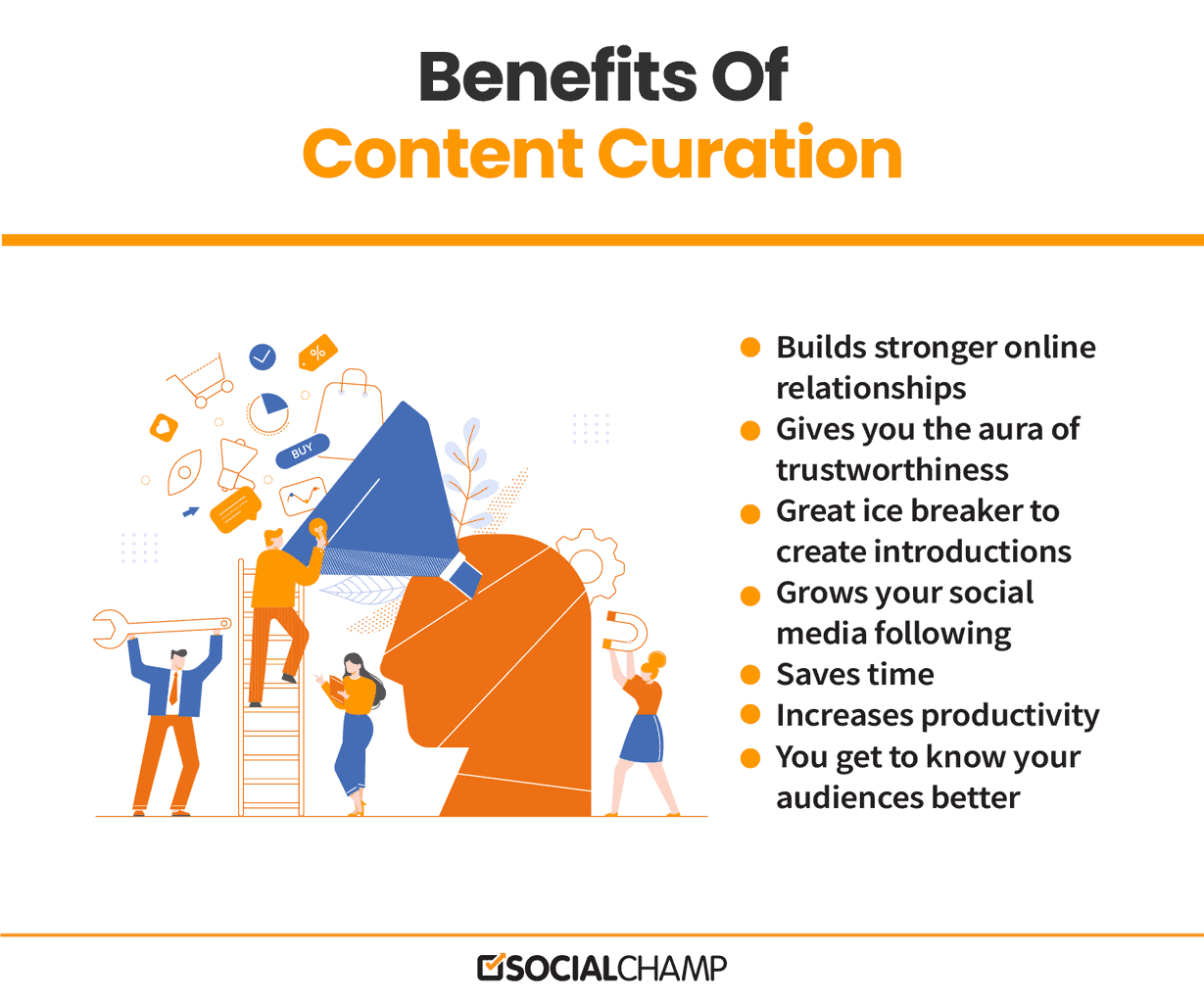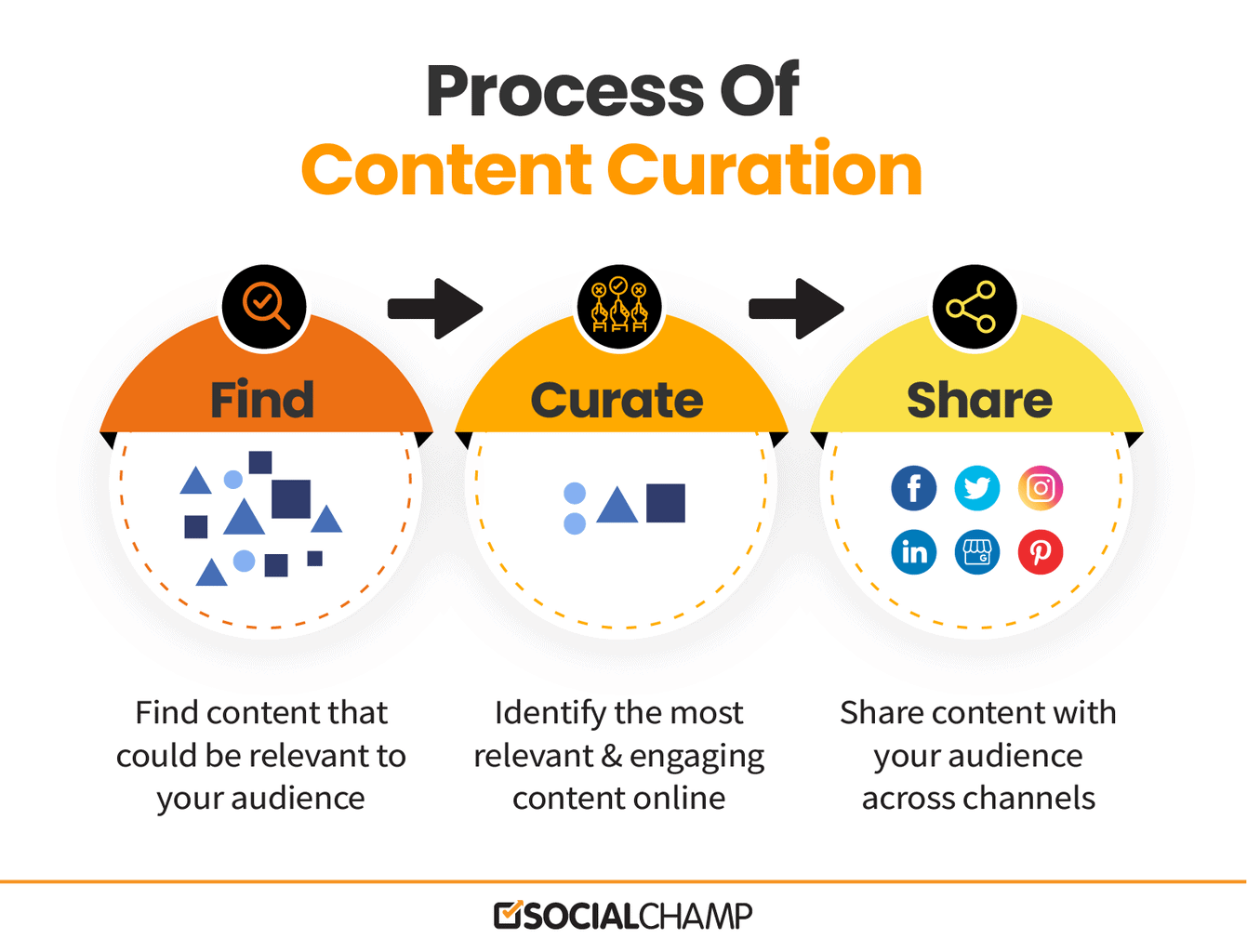The word “curation” seems a cool thing to do. Like curating music or art for an event. But what does it mean? What is the difference between content creation and content curation? How do you become a content curation pro? What is content curation marketing? What are the strategies that could make you an expert in content curation?
If you want answers to all of these, then you’ve come to the right place. Let’s start with what and whys of content curation. Moving forward in the guide, we will teach you how to boost your social media marketing with content curation.
What Does Content Curation Mean?
Content curation, in simple words, is the term used for the process of finding content relevant to your audience from a variety of sources online. And presenting the best pieces strategically through your communication channels. For example, compiling a list of social media influencers and sharing it with your audience.
The most important and fun thing about content curation is, it doesn’t involve creating your own content. You research information produced by someone else and share it on your channels that your audience will find insightful.
What Is the Difference Between Content Creation and Curation?
Content creation is way more different than curation. Content creation, in simple words, is a process of looking for a new topic, deciding the form of content, integrating a strategy into it, and then producing it. Creating your content. For example, writing a new blog post or a social media post on a trending topic.
The process of creating content is a little more complicated and time-consuming than curation. It may involve brainstorming sessions, thorough rounds of editing, and working with different teams before publishing the content.
Here’s how you can have a clear picture. Think of content creation as the first dance of any wedding. The amount of effort put together to select the music, mix the sentiments, personalize it, choreograph the steps according to the couple’s story, and rest to make it an unforgettable memory is what creating content is all about.
Whereas content curation is being the DJ, creating a playlist for the wedding guests. Your song selection is what makes you successful. Compiling a playlist knowing your audience. Giving them the confidence that this is what they want so they could enjoy being there.
You can think of it as the difference between writing a story and posting it to all your social profiles vs. compiling a list of best stories and share it with your followers (The BuzzFeed thing).
Which one sounds easier? Creating original content or gathering existing relevant information and sharing it? After all, masterpieces like Harry Potter aren’t produced daily!
Why Is Content Curation Important?
According to a survey, only 5% of marketers said they have never shared third-party content on their social networks. 75% of the content marketers said that it is a daily struggle to produce enough quality content to keep the audience engage on each social channel.
First, we need to understand the significant difference in concepts and theories of traditional marketing vs. digital marketing.
One of the theoretical foundations of traditional marketing was”creating as much original content as possible.” But, with the amount of information we’re dealing with today, even traditional marketers now agree that creating original and engaging content daily is an unrealistic task.
Social media marketing has made content marketing almost a daily task. Previously, traditional marketing channels didn’t require a daily injection of fresh content.
Today, even the best creative heads and marketing teams can’t create content with such frequency, which gives content curation a significant rise. Digital marketers now depend more on other sources for ready content to share it from time to time.
Content curation adds value to your brand, like all other facets of digital marketing. It helps you create lasting relationships with your consumers.
41% of marketers have proven that curated content has increased their sales-ready leads’ number and/or quality.
What are the Benefits of Content Curation?
Content curation benefits everybody. It helps the distributor whose work you are sharing. It helps your clients by sparing them time from searching for extraordinary data. And it benefits you by keeping your clients drew in and making the most of your brand. By curating content, you can produce new thoughts for your own content strategy while gaining the regard of your friends in the business.

Is Content Curation Good for SEO?
Content curation can likewise support your search engine optimization efforts by helping you gain inbound links from other persuasive sites.
Start by making a rundown of definitive, influential sites showing a willingness to link to different resources. Either through blog content, news roundups, or”how-to” guides.
Share their articles on your social channels and email lists, and ensure they know after you’ve done it. It would be best if you interacted with them in their blog comment section or through email. Ensure your communications with them. Show that you have a genuine appreciation for their work by posing great questions and making intelligent remarks.
Whenever you write on a related subject, reference them in your article, and after you share it with your fans, inquire as to whether they would consider sharing it with theirs. Try not to expect profit. Even though your company has promoted their work, it doesn’t commit them to do the same. Your odds of getting shared and linked to are far more prominent when you have put in the exertion of building up a genuine relationship with your prospect.
Is Curating Content Ilegal?
Consent is everything. Curating content doesn’t mean scraping or copyright violation. You can’t copy someone else’s work & place it on your social media or website as your own. That would be illegal.
Copyright laws protect all web content. Any blog, image, article, news, video, or anything else created by someone else used without permission is illegal.
How to do it Legally?
If someone is sharing any information online publically, that doesn’t mean that you can own it without giving them credit. Make sure you always credit the source. If you’re sharing their information on your website, always credit the source with a backlink to avoid duplication and plagiarism issues.
Ask the creator’s permission before using it in your production. Delete the post right away if you receive any request from the creator to remove it. If it is a social media post, make sure you mention or tag the original source. When sharing an image or video from another page to your page, try to share it directly from the share button instead of downloading and uploading it.
What Does a Content Curator Do?
In marketing, the content curator’s main job is to keep the content relevant, fresh & engaging on multiple social networks. And for that, he’s responsible for finding, sorting & sharing the content that is best for the audience. To achieve a better result, you may even need the help of an SMM specialist, a photographer, or an essay writer which will help make your content really worthwhile.
What is Content Curation in Marketing?
“Content curation is your rhetorical lift in the never-ending ocean of content.”
Here’s a simple case. Imagine the corner coffee shop owner in your locality takes a microphone and yells about how great his coffee is and that there’s a free bagel on every purchase. All. The. Time.
Don’t Use Social Media as a Megaphone for Your Brand Promotion
At first, it would be great stuff for marketing. But soon, people will be annoyed. They will start avoiding going even near his café, as he will start screaming in their ears. No matter how great his coffee or bagel is, the coffee shop owner will begin losing his business thanks to his antics.
This is precisely what you will be doing by sharing only original content to promote your brand. Yelling and screaming about your coffee into their screens. Once your audience is bored (which won’t take that long), they will try to avoid you at all costs, no matter how great your original content is. Sharing self-promoting branded original content might take away your loyal and old customers too.
What is the Process of Curate Content?

While searching for the perfect curation topic, consider these three factors:
- Competitive landscape
- Content landscape
- Interest of audience
For an ideal piece of curated content, you should look for a relatively low competition topic. But, there’s sufficient content available for you to dig into. The topic should be relevant to your audience.

Source: Curata
As shown in the above Venn diagram, your topic should fall in the middle of it.
1. Check the competitive landscape
Here are five simple questions you should ask yourself while looking into your competitor’s landscape for curation topic:
- Can you curate better than them?
- Is there a better perspective on this?
- Can you curate the same content from a different angle?
- Will you be able to broaden or narrow the specific topic?
- Will this increase your content’s discoverability?
2. Check the availability
Write your desired keyword or topic into Google news and see how many search results you can get. Sort them by date and look at how many pieces of content are created on the topic per week or day.
Check it on Twitter, Facebook, and LinkedIn too. Search by relevant hashtags, if there are any. Review all the news, visual content, and blogs.
Here are a few resources you should look for in your curated collection:
- Trade publications
- Twitter lists
- Specific Twitter users
- Industry blogs
- LinkedIn Pulse
- Feed readers
- Email newsletters
- Public relations team
- Scientific journals
3. Check your audience interest
Once your topic passes the above two checks, here comes the most crucial hurdle. You have to make sure that the curation topic meets the interest of your business’s target audience. If they don’t find it interesting, your curated content will fail to give your social media marketing the boost you’re expecting.
You can use Google Keyword Planner to check the general interest of the online audience in the given topic. Or you can do a simple survey to get the opinion about your topic. Ask your audience how they feel about the topic in your Instagram stories, or a live session, or by creating a poll.
Simplify your Content Curation Process with Social Champ
Look for new ideas through Content Suggestion. Share the latest content from your favorite blogs automatically with our Auto RSS feature. Make the most of your curation process with Social Champ.
Where to share
Identifying the topic for curation, collecting, and organizing the content is all behind-the-scenes preparation for the final sharing of your curated collection. This will be the moment of truth.
As a content curator, you need to decide where your target audience is. And which channels are the best suited according to your audience? Following are a few channels you can take action on:
- Social media channels
- A dedicated site/blog
- A news widget
- An email newsletter
- Feed
What are the Examples of Content Curation?
1. Larry Kim on Twitter
Larry Kim, the CEO of mobile monkey, has built a huge audience through content curation. He not only tweets about marketing stuff but adds content that is humorous and emoticon-rich.
Detecting parking space available in real time using deep learning
© Source: https://t.co/tJ2kFY2kVa pic.twitter.com/dtP9q2QGCw
— Larry Kim (@larrykim) September 1, 2019
2. SanDisk on Instagram
You might wonder how poor SanDisk can look good on Instagram when all they have is flash storage solutions! Here’s how you can make memory cards and flash drives look cool. And this is how creative you can go with curated content. SanDisk spices its Instagram feed with user-generated photos.
View this post on InstagramiXpand frees up space on your iPhone, without Wifi! | Photo: @kotuttle
A post shared by SanDisk (@sandisk) on
3. Bark on Pinterest
If you have a Pinterest account for your brand, too, content curation isn’t an option there. Every pinner is expected to curate content. Save pins from other accounts. Here’s how Bark does it.

4. IBM on LinkedIn
Here’s how IBM uses LinkedIn smartly by avoiding any heavy tech jargon and sharing posts that have a human factor in them.
5 Content Curation Strategies to Boost Your Social Media Marketing
Following are five simple content curation strategies and tips you can use to boost your social media engagement.
1. Content Distribution
Let’s start by sharing 60% of curated content and 40% of created content. And then adjust it according to what resonates with the audience. The best way to divide the content on social media is by using the 5-3-2 rule. You can read more about the 5-3-2 rule in this blog.
2. Use Trusted Experts to Curate Content
No one can be an expert in everything related to their field. That’s why sharing content from trusted, reputed, and authentic sources of the same niche will not only help you learn about new things but will show your followers that you know more. Sharing curated content is a great way to establish yourself as a trusted advisor. And also to grow your audience.
3. Be Consistent
As everyone says, “consistency is key.” It’s one of the key fundamentals to be successful. To be consistent with original content is an impracticable approach. No one can produce unique content regularly. (Not even daily vloggers on YouTube, they also need a break after a while). To fill the holes in your social media schedule when you’re not creating content, you can use curated content. It saves time and keeps up with consistency.
4. Avoid Duplication
Consent is everything. If someone is sharing any information online publically, that doesn’t mean that you can own it without giving them credit. Make sure you always credit the source. If you’re sharing their information on your website, always credit the source with a backlink to avoid duplication and plagiarism issues.
If it is a social media post, make sure you mention or tag the original source. When sharing an image or video from another page to your page, try to share it directly from the share button instead of downloading and uploading it.
5. Add Your Own Spices
Add a little something original to the curated content. Give your opinion or insight on the curated and shared topic. Add something unique. A new angle to the story isn’t mentioned yet in the story. Add something people could relate to. Just remember to maintain the balance between the original and the source.
Content Curation with Social Champ
Simplifying the process of content curation for marketers
Social media management tools like Social Champ can make the process of content curation much easier for you. Social Champ gives you the power of curating content in a few simple clicks.
Once you have identified your curated topic by following the tips mentioned above, all you have to do now is type that keyword or phrase in the search bar in the suggestions tab. Social Champ scans all the articles across the Internet on the given topic and shows you the best content suggestions.
To have a stream of relevant content from authentic sites daily, you can also add your favorite blogs through the RSS feed. This will keep you updated about the latest news from your favorite resources. And the best part is, you can directly share any posts from these sources to your social media accounts within the app.
If you wish to automate the process, post a blog post on your social profiles once or twice a week from any website; you can add it to the Auto RSS feed. Set the frequency, customize it by adding a headline or hashtags if you want, and set the schedule. To access all these amazing and easy-to-use features, sign-up for your free trial today.
Key Takeaway
When it comes to digital marketing, the one who has the best content wins. It is also annoying to read the entire blog post and, in the end, find out that the answer you got so far is “it depends.” But how frustrating this sounds, social media marketing, and digital marketing can never have a “one size fits all” strategy.
Every business and every brand on social media has its own goals, not necessarily the same. And to reach those goals, each brand has to come up with a unique digital marketing strategy. If an approach works out for someone pretty well, that doesn’t mean that it will do the same for others. Digital marketing strategies vary from business to business.
Putting it simply, you will get more engaging followers when you offer them valuable and exciting content. And adding content curation to your strategy can help you do so. Start the tips mentioned in this guide.
- Avoid curating offensive content.
- Start with the 5-3-2 rule for content distribution.
- Keep Tracking your ROI. – It will give you a complete insight into how often you should share created content and curated content.














